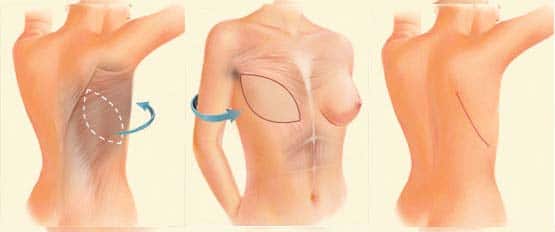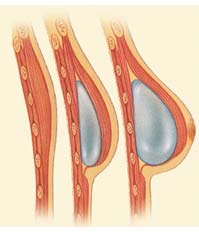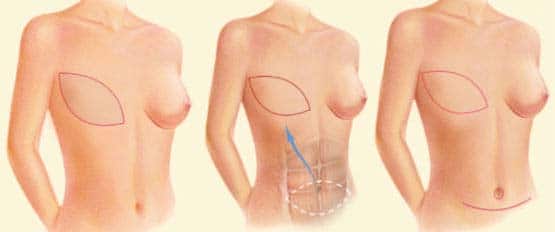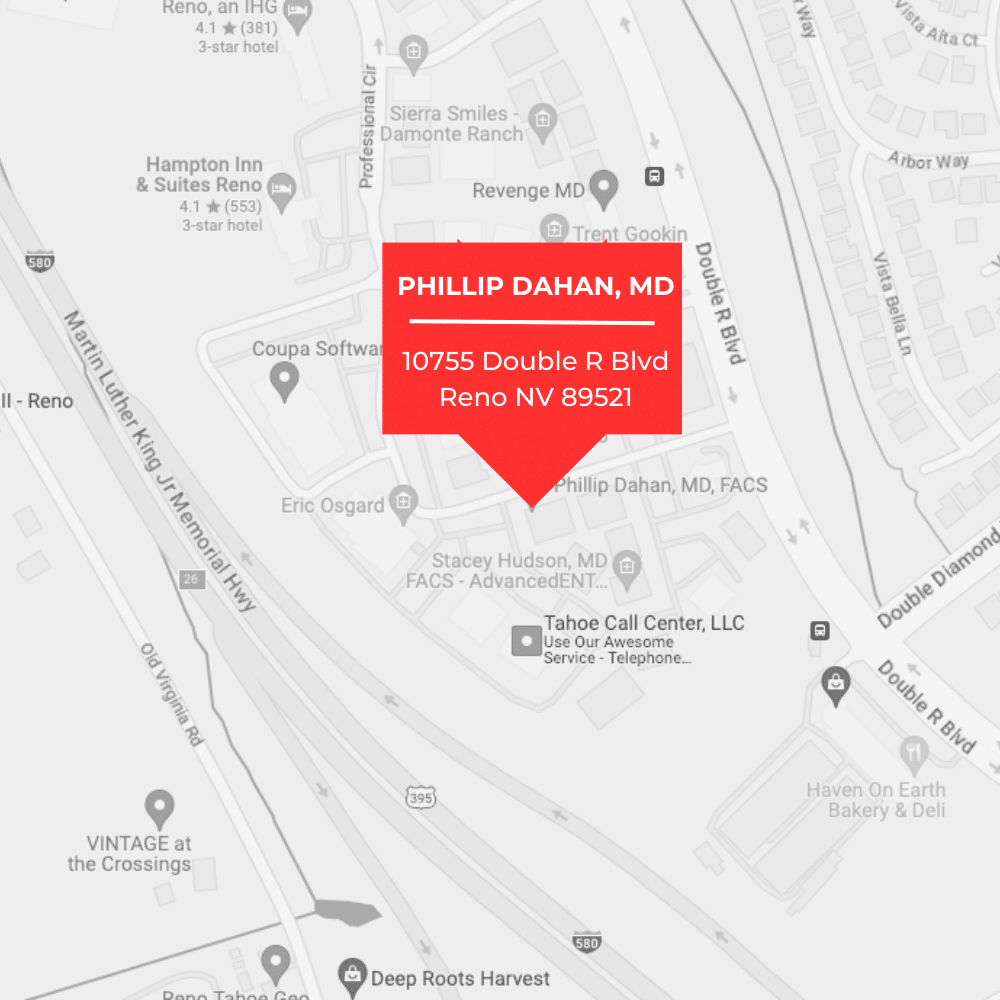Breast reconstruction, an integral part of breast cancer treatment, is frequently performed by plastic and reconstructive surgeons. In Reno, Nevada, Dr. Dahan has performed hundreds of unilateral and bilateral breast reconstruction surgeries. He offers several advanced breast reconstruction techniques for his patients. If you are considering breast reconstruction, you can turn to Dr.Dahan for advice and treatment in this emotional but rewarding reconstructive procedure. The surgery uses breast implants or your natural tissue to restore the breasts after cancer and mastectomy. Dr. Dahan frequently performs immediate breast reconstruction at the time of the mastectomy working together with your cancer surgeon. In some cases, patients are advised to complete their cancer treatment first and then undergo delayed breast reconstruction.
Am I A Candidate For Breast Reconstruction Surgery?
All breast reconstruction procedures are performed to restore one or both breasts after mastectomy or lumpectomy. While mastectomy and lumpectomy can help eliminate breast cancer, they can also cause significant asymmetry, deformity and the loss of feminine shape. Patients considering breast reconstruction are mentally and emotionally ready for a demanding surgical procedure. Many plastic surgeons recommend breast reconstruction immediately after mastectomy. However, in some cases, the reconstruction is delayed until the patient feels fully prepared and has completed their chemotherapy and/or radiation therapy.
What Our Patients Have To Say
“My husband and I would like to say our heartfelt gratitude and thanks for the surgery you performed on me. I will always treasure the gift you gave back to me that cancer had taken away from me. Dr. Dahan, from the first day we met you, and throughout our whole ordeal and experiences, you have been most kind and an honorable gentleman with a heart of gold. This Thanksgiving, I can look at myself and feel like I am a whole person again. Thank you for being such a brilliant and kind doctor. We are truly lucky, blessed and grateful for everything you have done for us.”*
Warmest and deepest regards,
Sue (breast cancer survivor)
How Is Breast Reconstruction Surgery Performed?
The goal of breast reconstruction is to restore a natural, feminine appearance.* This can be achieved using several different methods. The most useful distinction between the available procedures is the use of breast implants or natural body tissue flaps. When breast implants are used (filled with either saline or silicone gel), Dr. Dahan will often use a tissue expander (or an expanding implant) to first create space for each device. The implant can be placed above or below the pectoral muscle, depending on the patient’s needs and her body type.
Autologous breast reconstruction is more technically advanced but preferred for patients who want natural tissue to restore the lost breast. These methods include techniques such as Fat Grafts, the TRAM flap and Free flaps.
The techniques vary in the source of the grafted tissue, and the source of the blood supply which allows the graft to survive in a new location. Several techniques transfer skin, fat and muscle from the abdomen, while others obtain the needed tissue from the back or buttocks.
What Is The Latissimus Dorsi Flap Breast Reconstruction Procedure?
The Latissimus Dorsi Muscle Flap procedure is a very effective and popular breast reconstruction technique to help patients regain their confidence and well-being while recovering from a mastectomy or injury. The procedure involves taking skin and muscle from the back to create a natural-looking breast mound. The Latissimus Dorsi Muscle Flap breast reconstruction procedure is known to be less complicated than other procedures, which can reduce recovery time and lessen the overall impact of the entire breast reconstruction process. This technique almost always requires the placement of an implant under the muscle flap. Dr. Dahan currently performs this procedure without taking skin from the back, using only the muscle and your leftover breast skin. This prevents you from having scar on the back and only requires the use of your existing mastectomy scar without creating other scars.

Tissue Expanders
Tissue expansion involves the rebuilding of the breast by expanding the remaining skin following a mastectomy or injury. The insertion of the tissue expander can often be done during the mastectomy, working in conjunction with your breast cancer surgeon. The procedure involves the placement of a silicone balloon just under the pectoralis major muscle and the skin, and then the injection of a saline solution into the balloon in a number of sessions over a period of several months to continue to gradually expand the skin. After the initial surgery to place the tissue expander, the progressive expander injections take place in a quick procedure in the office and only lasts about 10 to 15 minutes.
Over time, the balloon will expand the skin and muscle, ultimately creating a breast mound and a pocket to house an implant. After the skin and muscle have grown sufficiently to accommodate the implant, the balloon expander is removed and the breast implant is placed to create the breast mound permanently.

Breast Implant Placement
In the second surgical phase of Tissue Expansion breast reconstruction, a saline or silicone breast implant is placed. During this procedure, the tissue expander is removed and Dr. Dahan will replace it with the implant. The exact type, shape, and size of the breast implant will be decided by the patient and Dr. Dahan. After the implant has been placed, the incisions are closed and the recovery process begins. Once the breast has healed properly, Dr. Dahan can reconstruct the nipple to complete the breast reconstruction with results that look as natural as possible.
As an additional option to improve the effectiveness and possibly alleviate the need for a separate procedure, the Tissue Expansion breast reconstruction method can be performed during a mastectomy. However, for our patients who have opted for delayed reconstruction, the tissue expansion method can just as easily be performed following the recovery period for the initial reconstruction procedure
TRAM Flap
A TRAM Flap uses donor muscle, fat, and skin from a woman’s abdomen to reconstruct the breast. There are two basic methods of performing the TRAM Flap breast reconstruction procedure: the pedicle flap procedure, and the free flap procedure.

Pedicle Flap
This procedure is often called the “standard” in breast reconstruction and has been in use for more than twenty years. Pedicle Flap breast reconstruction involves a technique called “tunneling,” utilizing tissue and part of the abdominal muscles to create a reconstructed breast mound. An added benefit to the pedicle procedure is that through the process of taking skin and fat from the abdomen, patients may have a flatter midsection. In order for the transfer of the flap to the chest to work, the abdominal muscle must be tunneled under the upper abdominal skin and connected to the breast site, where the tissue from the donor site will be used to create the new breast. The pedicle flap technique allows many of the blood vessels to remain intact and therefore does not require microsurgery. This procedure is often quicker to perform and has proven itself to be a remarkably successful technique for rebuilding the breasts with natural-looking results.
Free Flap
The free TRAM flap is a microsurgical technique, requiring the meticulous connection of blood vessels under microscopic magnification. In this procedure, abdominal skin, fat and a portion of the muscle (along with its blood vessels) are removed and placed in the chest area, where it is shaped to create a new breast. The artery and vein of the donor tissue are reconnected to blood vessels in the chest, creating a healthy blood supply to the new breast.
At the initial consultation, Dr. Dahan will explain all the breast reconstruction procedures available, to ensure each patient is informed and aware of all their options.
Nipple Tattooing
The final step in breast reconstruction is often recreating the nipple and the areola, which is the dark-pigmented area that surrounds the nipple. This can be achieved by nipple reconstruction procedures and nipple tattooing. We offer nipple tattooing on an outpatient basis, which is the final step in the nipple reconstruction process.
Nipple tattooing involves the medical use of typical tattooing equipment, with the ultimate goal of creating a natural-looking nipple, which compliments skin color and tone. A variety of pigments are used to match the color of the remaining nipple, or in the case of a bilateral reconstruction, to the patient's pre-operative photos, as the color of the skin before the tattooing process depends on where the initial skin graft comes from. While nipple tattooing can create the appearance of a realistic nipple, patients should understand that tattooing alone will not create the same natural-looking appearance as complete nipple reconstruction, and may require multiple treatment sessions to achieve the correct color as our surgeons and patients strive for the best possible reconstruction results. Regardless of whether our patients decide to include nipple tattooing or a complete nipple reconstruction in their breast reconstruction treatment plan, Dr. Dahan will provide comprehensive educational information during the initial consultation to ensure the correct decision is made for each individual patient.
Nipple Reconstruction
Nipple reconstruction is performed as a separate surgery after the implant or flap breast reconstruction surgery is complete. The reconstruction of the nipple and areola (the pigmented area surrounding the nipple) afford Dr. Dahan the ability to create the most natural-looking breast reconstruction results possible.
Graft Nipple Reconstruction
In a graft nipple reconstruction, Dr. Dahan will take skin from a donor site and attach it to the newly constructed breast. The donor site for the nipple can come from the nipple of the other breast in cases of a single-breast mastectomy, or from the earlobe or labia if a double mastectomy is being performed. The donor site for the areola can come from a variety of areas, including the scar from a flap reconstruction procedure, the crease of the buttock, or the inner thigh.
After Breast Reconstruction: What to Expect
In general, breast reconstruction patients can expect to be tired and sore for one to two weeks after surgery. Pain during recovery is managed with prescription medication. Stitches may need to be removed after about one week. In some cases, the breast reconstruction process consists of several procedures or stages, which gradually restore a normal appearance. Later stages of the operation may include reconstruction of the nipple, adjustment of the breast size, or operations to enhance breast symmetry. Adjusting to the results will take time, so patients should be prepared for both the mental and physical challenges involved.*
Choosing a plastic surgeon is one of the most important decisions to make in breast reconstruction. If you are located in the Reno and Lake Tahoe area, we encourage you to schedule a consultation with Dr. Dahan. Dr. Dahan is trained in many of the most advanced breast reconstruction techniques, so he is fully prepared to discuss this important procedure with you.
Schedule A Consultation
For more information about Breast Reconstruction Surgery, please contact Dr. Dahan's office at (775) 826-4477.
*Individual Results May Vary



